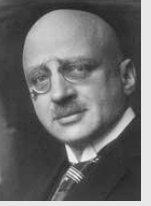Fritz Haber
chemist, b. 9 December 1868 (Breslau, Silesia, Prussia), d. 29 January 1934 (Basle, Switzerland)
 Fritz Haber came from an old established family of Christian faith in Breslau's Jewish community. He studied chemistry from 1886 until 1891 at the Universities of Heidelberg and Berlin and at Berlin's Charlottenburg Institute of Technology. Having completed his studies he joined his father's business, but incompatibility of tempers led to leave and follow an academic career.
Fritz Haber came from an old established family of Christian faith in Breslau's Jewish community. He studied chemistry from 1886 until 1891 at the Universities of Heidelberg and Berlin and at Berlin's Charlottenburg Institute of Technology. Having completed his studies he joined his father's business, but incompatibility of tempers led to leave and follow an academic career.
After a short period at the University of Jena Haber was appointed assistant to the Professor of Chemical Technology at the University of Karlsruhe. In 1906 he was appointed Professor of Physical Chemistry and Electrochemistry and director of a new institute established for that research area. In 1911 he moved to Berlin to become Director of the Institute for Physical and Electrochemistry.
His work as a teacher led Haber to publish two textbooks that became standard references, Grundriss der technischen Elektrochemie auf theoretischer Grundlage (The Theoretical Basis of Technical Electrochemistry) in 1898 and Thermodynamik technischer Gasreaktionen in 1905 (The Thermodynamics of Technical Gas Reactions, 1908). As the title of his works indicates and Haber expressed in the preface to the first work, he wanted to relate chemical research to industrial processes.
During the years before World War I Haber undertook research on a wide range of problems including the electrolysis of solid salts, the loss of energy by steam engines and the study of flames, that led to new techniques in chemistry.
At the outbreak of World War I Haber got caught in the general wave of nationalism. He placed his laboratory at the service of the government and worked on problems created by the drying up of supplies. He showed, for example, that xylene and the solvent naphtha were good substitutes for the now unavailable toluene as an antifreeze in benzene motor fuel.
Of even more importance to the war effort was a process, now known as the Haber-Bosch process, for the industrial production of ammonia, until then only available from natural deposits outside Germany. Its invention resulted in the establishment, with the cooperation of Bosch and Mittasch, of the Oppau and Leuna Ammonia Works for the production of nitrate-based explosives. Modifications of the process also provided the base for the industrial production of the fertilizer ammonium sulphate. Haber's work laid also the foundation for the synthesis of methyl alcohol by Alwin Mittasch, for the hydrogenation of coal by the method of Bergius and for the production of nitric acid. For this work Haber was awarded the Nobel Prize for Chemistry in 1918.
As the military confrontation developed into trench warfare Haber promoted the use of gas to break the stalemate. On 22 April 1915 he personally directed the first gas attack at the front lines. About 150 tons of chlorine were blown across the fields of Flanders, Belgium; between 5,000 and 15,000 Allied troops were wounded or killed in a single day. A few days later his wife Clara picked up Haber's Army pistol and committed suicide. The Allied Forces soon developed countermeasures against gas warfare, and gas did not decide the outcome of the war.
Germany's defeat affected Haber greatly. He became acutely depressed and felt personal responsibility for it. In an attempt to assist the raising of the reparation payments he began in 1920 a programme to distil gold from seawater but had to admit six years later that, although the gold reserves in the ocean are huge, the concentration is too small to make extraction profitable. He continued to run his institute and served on the League of Nations Committee on Chemical Warfare.
With the coming to power of the National Socialists in 1933 Jewish employees of Haber's institute were dismissed. Although Haber himself was safe from persecution on account of his World War I record, he resigned in sympathy with his Jewish colleagues and went to Cambridge, England. When he died on a trip to Italy in the following year he was investigating a possible senior research position at Rehovot in Palestine (today's Israel).
After Haber's death the Institute for Physical and Electrochemistry in Berlin was renamed the Fritz Haber Institute. The Fritz Haber Center for Molecular Dynamics Research at the Hebrew University in Jerusalem was established in 1981 with the goal to support research in molecular dynamics and encourage cooperation between German and Israeli scientists.
References
Coates, J. E. (1995) Fritz Haber, Encyclopaedia Britannica 15th ed.
Nobel e-Museum, the Official Web Site of The Nobel Foundation (2004) Henri Becquerel. http://www.nobel.se/chemistry/laureates/1918/haber-bio.html (accessed 25 July 2004); based on Nobel Lectures. Chemistry 1901-1921, Elsevier Publishing Company, Amsterdam, 1966.
National Public Radio (NPR) (11 July 2002) The Tragedy of Fritz Haber. http://www.npr.org/programs/morning/features/2002/jul/fritzhaber/ (accessed 29 July 2004).
home
 Fritz Haber came from an old established family of Christian faith in Breslau's Jewish community. He studied chemistry from 1886 until 1891 at the Universities of Heidelberg and Berlin and at Berlin's Charlottenburg Institute of Technology. Having completed his studies he joined his father's business, but incompatibility of tempers led to leave and follow an academic career.
Fritz Haber came from an old established family of Christian faith in Breslau's Jewish community. He studied chemistry from 1886 until 1891 at the Universities of Heidelberg and Berlin and at Berlin's Charlottenburg Institute of Technology. Having completed his studies he joined his father's business, but incompatibility of tempers led to leave and follow an academic career.